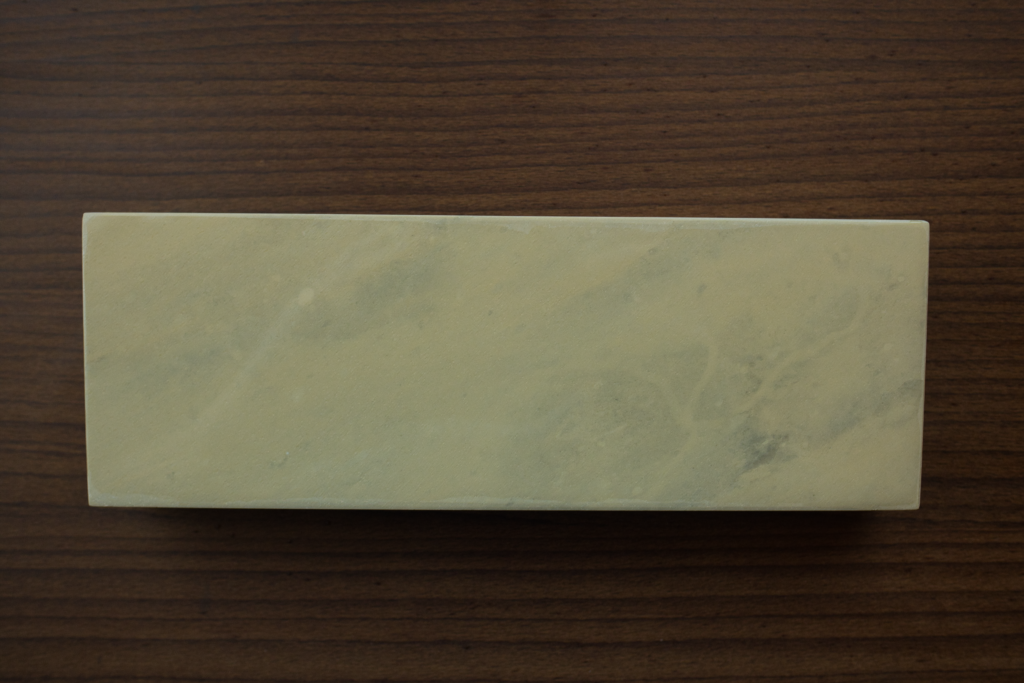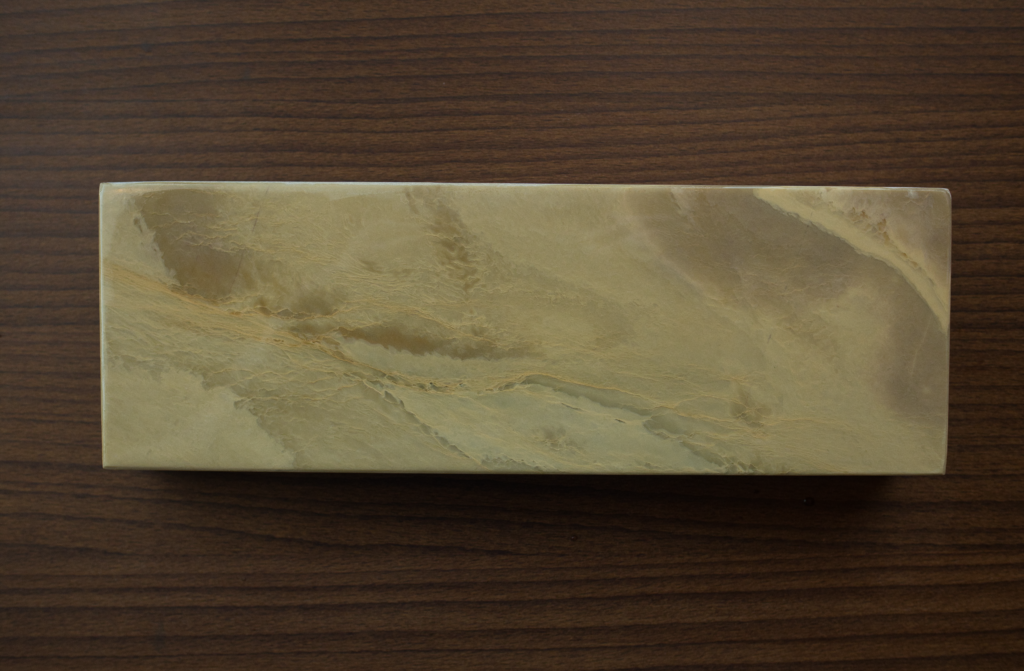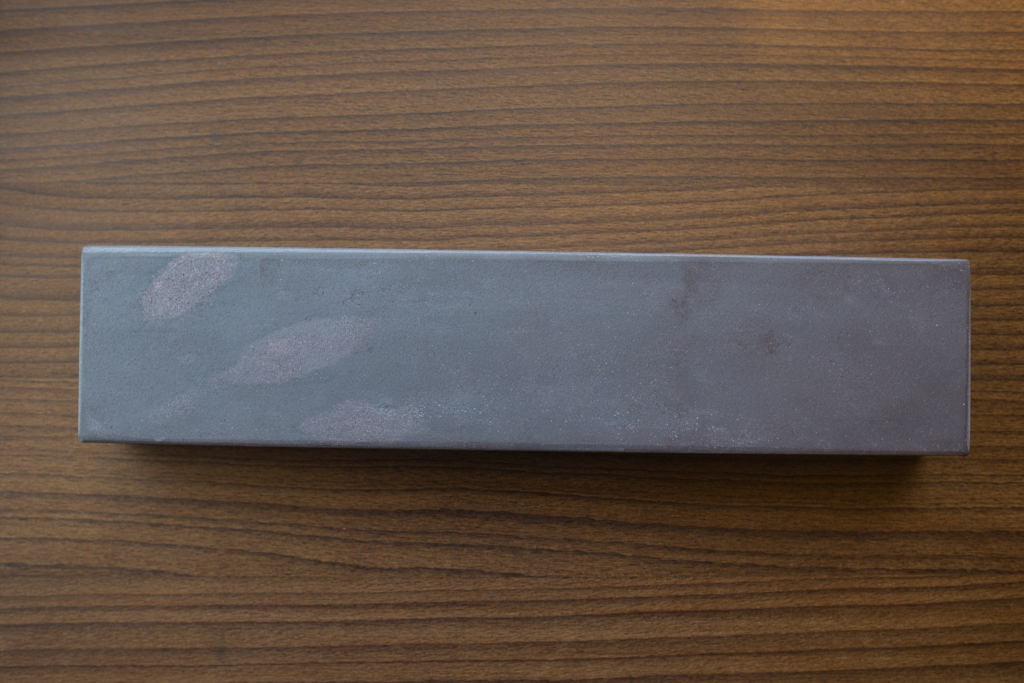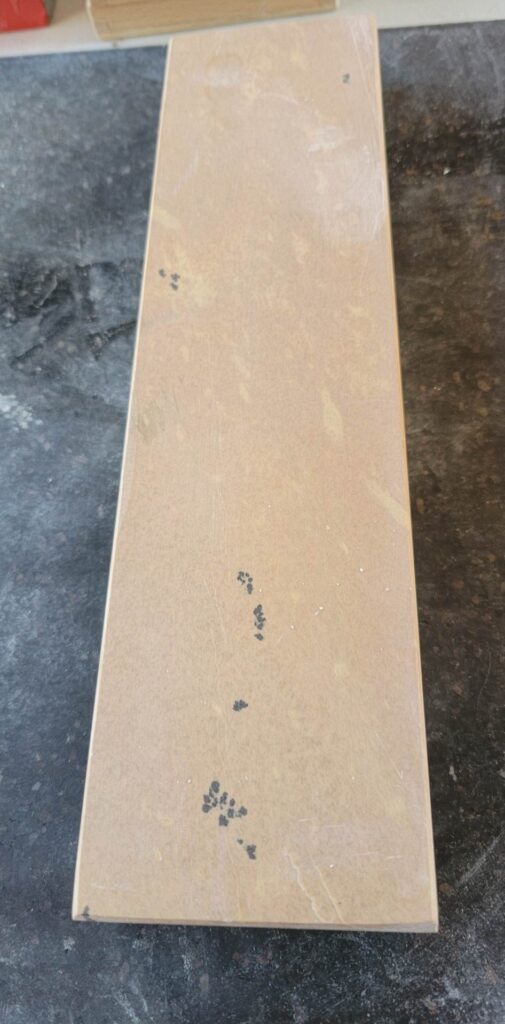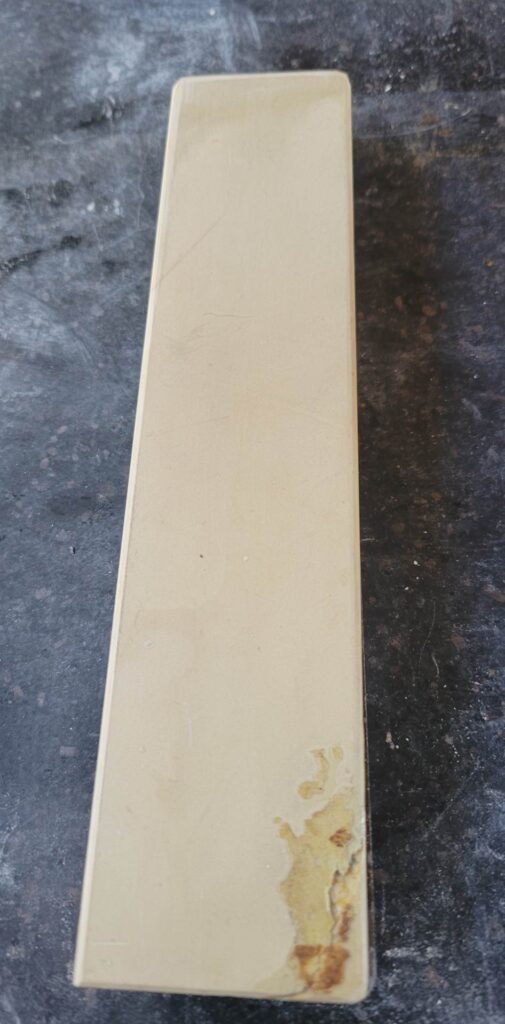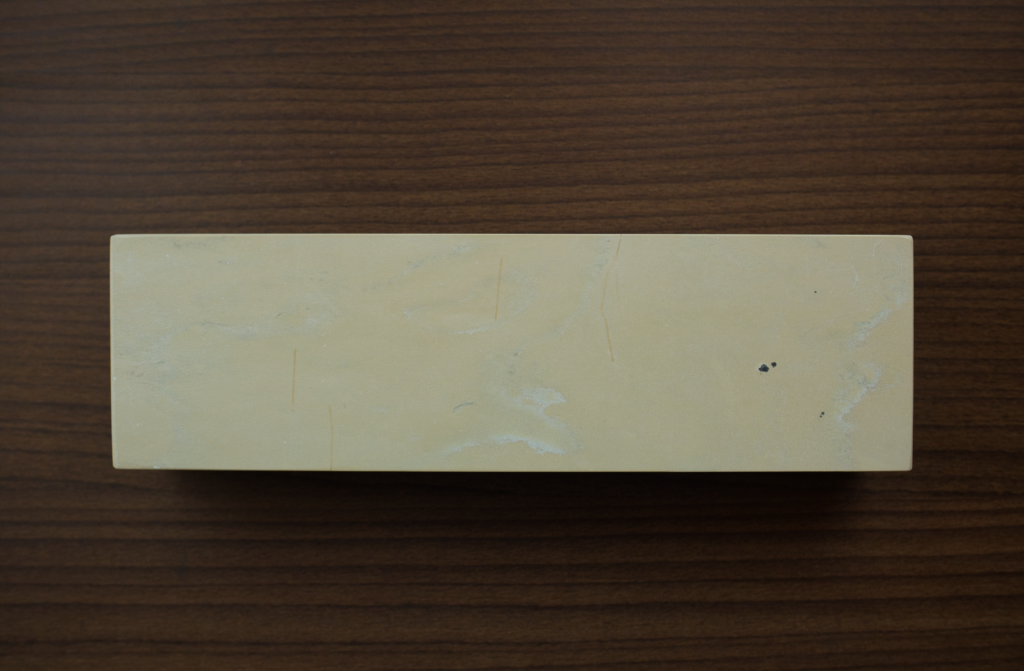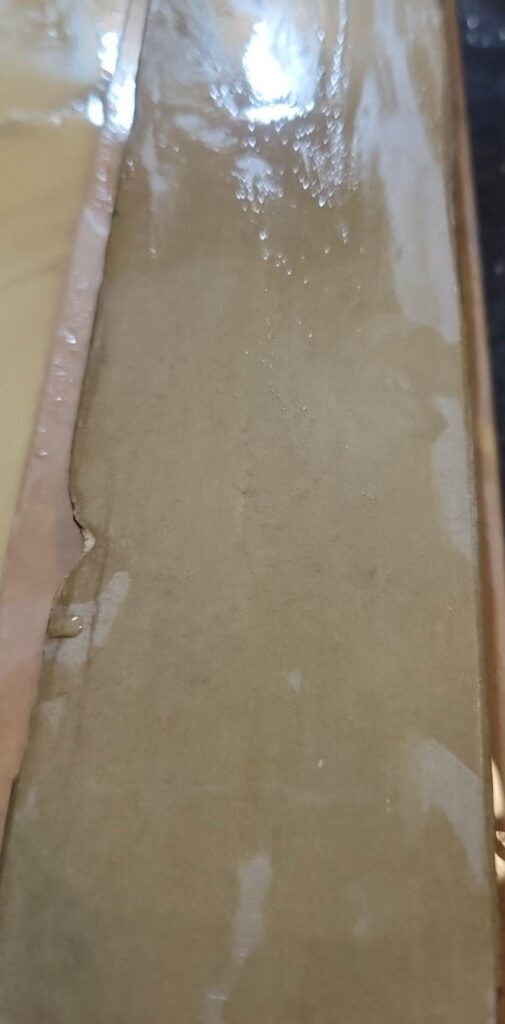Coticule stones originate from Belgium and have been used for thousands of years in the creation of natural whetstones. These whetstones have a great variety of grit depending on how their slurry is managed and the mine vein they originate from. A rough estimate of analogous grit would be between 1000 and 12000. Without outliers factored in, it would be much more astute to say within the 5000 to 8000+.
The coticule’s abrasive substance is principally garnets with few exceptions. The standard razor hone level coticule contains between 20-42% garnets within it’s make up, and roughly 40% of these garnets are within the 5-15 micron range. The relative density of the stone’s makeup is 2.8-3.3. There are coticules below this level which are considered “medium coticules” and not often sold as razor hones. Similarly, there are coticules above the 42% level which suffer from garnet tangling within their surface, drastically decreasing their effectiveness.
The binding material of coticules is a loose composition of quartz and mica. This binder is one of the things that makes coticules extremely effective sharpening stones and hones. The binder plays a minor role in sharpening but does influence it. Additionally, the soft nature of the binder allows new garnets to be easily released to continue the effective sharpening process.
Similar to all other natural stones used for sharpening, we must use ranges due to the varying nature of each specimen. Throughout this area (as we have done above), a generalization of veins and types of coticules will be presented. It is important to take these as guidelines and not firm rules as each stone must have its unique properties tested before knowing it’s character.
Sections
Coticules vs JNATs & Coticules vs Thuringian/Eschers
Using Coticules
Coticule Grading
Coticule Veins
Les Latneuses
Belgian Blue Whetstones (BBW) & Rogue du Salm / Lorraine
La Dressante Top Layer
La Dressante au Bleu
La Veinette
La Petite Blanche
La Grosse Blanche
La Grosse Jaune
La Grise
La Verte
La Nouvelle Veine
La Veine aux Clous
Further Information
Coticule vs JNATs & Coticule vs Thuringian/Eschers
When compared to other natural stones, Coticules require the user to work “around” the inherent qualities of the stone more than other natural stone. Coticules which are suitable for razors (the majority are not without oil contrary to their reputation) will work easily to refine an edge but a significant number of Coticules will not produce a satisfactory razor edge without oil. Unlike most Thuringian/edge, or medium/hard level Awasedo JNATs which will produce a razor edge with great ease, the Coticule’s garnet cutting material are often larger and more aggressive than the silica found within other stones. This requires the user to make up for some of those shortcomings.
Additionally, the Coticule slurry does not work like many other slurry-oriented natural stones. Whereas with a JNAT or Thuringian you will work the slurry – which breaks down the binder containing the very fine grit silica/quartz – with a Coticule you have to slowly dilute the slurry to get different levels of fineness. Note though that this dilution method will not result in a finer edge than the stone’s natural abilities, thus if the stone cannot make a great razor edge touching up an already functional razor with water only – the dilution method will not produce a good edge at the end. Working the slurry from a Coticule will not result in any finer of a slurry, so you must utilize this dilution method to achieve a satisfactory result.
One benefit to the Coticule vs some other natural stones is they not naturally porous, allowing them to easily use oil as a honing medium to lower friction similar to the use of Arkansas/Charnley Forest/Crete stones as oilstones. This access to oil honing saves many otherwise lackluster Coticules when it comes to razors.
Some people will talk of edges off Coticules being “smoother or less aggressive”. This is true, but it is just a factor of the edge being less keen, there is no magic going on at the edge of the blade otherwise. This is similar to people running new safety razor blades through corks or otherwise to “tone them down”. Each individual’s needs for a razor are different, and if your use does not require the absolute keenest edge a more forgiving edge (so not as sharp) can potentially make for a less irritating shave and also allow for more slip ups while shaving (saving you from more cuts).
The benefit of Coticules versus other stones is the “jack of all” functionality. The composition and aggressive garnets allow you to use the same stone to bevel set and refine the razor, while using water only or oil if necessary to finish that same razor. There is a good chance that the stone head-to-head with a “master of one” stone will not feel as nice to use, but even JNATs lack the versatility of most Coticules.
Using Coticules
When utilizing coticules, an over-simplified presentation of the concept can be expressed as such for the beginner.
Note – The below information range ASSUMES a Coticule which could work for razors!
- Thick/Pasty Slurry: x600-x2000 analogous grit
- Thinner/Milk Slurry: x2000-x4000 analogous grit
- Very Thin/Foggy Slurry: x4000-x6000 analogous grit
- Standing Water Only: x6000-x7000 analogous grit
- Running Water Only: x7000-x8000 analogous grit
- Oil: x8000+ analogous grit
The above numbers do change some based on the vein the coticule is from. This skew commonly happens at the top end of the analogous spectrum. Some very fast cutting coticule specimens or veins may top out acting far closer to x5000 analogous grit. Note that many Coticule are actually not razor level coticules, and even using running water or oil may lead to an unsatisfactory shaving experience. This often is not stated in the advertisement and buying from someone who has tested it and can vouch for its good razor-level performance may be important.
All coticules are going to do a great job with knives, tools, etc. In matter of fact, though they lack popularity in those areas I think the coticule excels as a knife/tool sharpening stone. For razors (where we most commonly see them discussed) I find you are often working against the default grit of the stone – having to take additional steps other “razor” stones do not need to achieve a similar edge.
If you specifically want to use your fast coticule to finish razors or chisels you will need to look into using honing oil or glycerin. As mentioned above, one benefit to coticules regarding oil and honing solutions is that they are not naturally porous, so they will not absorb oil. I personally do not like working with oil due to the mess it makes. I also do not find it makes a large enough difference over other stones I consider “better” or maybe “more naturally suited” for razor work. I know many people though love their Coticules for razors, and love using oil on them. Experience will tell you where you fall on the subject!
Coticule Grading
When buying new Coticules, you will see them graded “Standard”, “Selected”, and “Select Plus”. These do not necessarily perform differently but they will look different. Standard may have black lines or spots in the coticule’s surface as well as potentially tiny cracks which will not impact sharpening. Selected will have possible hues as well as a lower number of imperfections such as lines and spots. Selected Plus will be more likely to have many hues and have no imperfections or spots.
Coticule Veins
Unless you are buying directly from the modern day source, you have a very well documented “old-stock” stone, or it has a very defining visual attribute (like Les Latneuses or La Petite Blanche) you may not know which Vein your stone comes from. You can visually look at it and guess based on the information below (if again, it does not have a visually defining attribute) but note it will always be a guess.
That may not be as bad as you think, as outside of Les Latneuses hybrid side and maybe La Veinette the performance of the vein is far from assured. Each coticule stone must be evaluated on its own for its own performance, and generally speaking you are not assured it will be at a level which can easily do razor work. Consider buying used from a reliable source if you want to ensure a certain performance level or talking directly with Ardennes-Coticule about your needs.
Les Latneuses Coticule
Notes
This coticule vein is first on the list because it has many properties that break from the mold of the rest of the coticules. It is never linked to a belgian blue layer, but instead linked to a unique layer referred to as the “hybrid layer”. Unlike other coticules, rather than a single coticule layer surrounded by BBW on both sides, this vein has the hybrid layer surrounded by coticule on both sides. The nuisances of this difference will be covered below. Similar to other coticules, the non-hybrid standard coticule layer has garnets as its primary abrasive substance, whereas the hybrid layer has chlorite and quartz particles as its primary abrasives. These quartz particles are extremely small, less than 1 micron, and offers unique abilities that other coticules may not have.
Visuals
The standard coticule layer will have a coffee with creamer color about it, a light beige. It is possible to also get manganese lines or dots within it, though not extremely frequent. At times, there can also be thin orange-brown lines running through the standard coticule. Slurry generated is creamy yellow. The hybrid layer is a mixture of colors, from browns, grays, to yellowish. It is often mixed and swirled together or looking layered in ways other coticule layers are not. Some will describe it as looking similar to marble.
Performance
Standard coticule layer is often soft and fast which will slurry easily. The two layers of coticule that surround the hybrid are different but both fast. The one with more blue hairs and lines tends to be a bit slower than the one without them, but both are considered fast when compared to other standard coticule veins.
The hybrid layer is moderate to slow in speed and very hard, generating a slurry very slowly. Compared to all the coticule layers, this is the slowest and hardest. Due to its very small micron size utilizing quartz abrasive, this side is fantastic for finishing blades on which need a very keen edge such as razor or high carbon cutlery.
Suitability
Tools, Knives, Razors
Belgian Blue Whetstones (BBW) & Rogue du Salm / Lorraine
Notes
Related to but not classified as the “coticule” layer, this blue stone in most instances has formed around the coticule layer. In many coticule stones, especially older stock ones, the back of the coticule stone is this Belgian blue whetstone (BBW) layer. This was a natural combination of the stones as the two veins formed next to one another in the ground. Typically, this helps to strengthen the smaller coticule layer, as well as providers a different grit option should you want it on the same stone. Stones which have the BBW on the back through the natural process are referred to as natural combo stones. For some veins of coticule or newer veins where it is harder to find suitable BBW combos, the coticule layer will instead be glued to slate which is not suitable for honing, or potentially a separately cut piece of BBW to mimic the natural combination. The stone is blue due to iron oxide which is present in large quantities throughout the stone.
It is also worth bringing up here the Rouge du Salm / Veine Lorraine stone which is not a coticule stone nor a BBW but a third type. It is a Schist stone with garnets similar to coticules. The reason this is important is, geologically, it is located between layers of BBW once it hits the Belgium area. At times, the layering forms mixed BBW/Lorraine stone that are on the backside of coticules. The more “wine red” the BBW layer is, the more highly mixed it is with elements of Lorraine stone. This is very common on the La Veinette, La Petite Blanche, and La Grise coticule stones and will present the BBW as a mixed blue and wine color in look and slurry coloration. Often, these mixed BBW stones are much finer than their standard BBW counterparts and can sometimes be finer or better finishing stones than the coticule itself (natural La Petite Blanche combination stones with Lorraine mixed BBW are often a good example this). Stones that are pure La Lorraine are often extremely difficult to find and will often be a bit less fine than the mixed BBW/Lorraine versions while being faster cutting than either the mixed of pure BBW stones. Pure Lorraine stones were often sold as “Pierre à Faulx” or “Whetstone with Flaws” due to the frequent presence of small holes throughout the stone’s composition. When lapped flat, these holes did not impact the stones performance.
Visuals
Ranges from deep blue to light purple. The visuals do not usually indicate any specific difference in quality but can help determine origin mine of the coticule. Such attributes where this can help are the color of the purple itself, and more frequently what the transition looks like between the tan colored coticule layer and the blue layer. It is uncommon to find inclusions within the blue stone, but you can find mixed coticules where some of the BBW is “leaking” into the tan coticule and some of the tan coticule is striping into the BBW stone.
Performance
This stone layer is extremely difficult to detail out the performance to. While it gets lumped into one large category of BBW, they can perform drastically different depending on how they formed. Often, BBW are advertised as a lower-level grit rating than the white/yellow coticule layer they are attached to – but in my experience you have about an equal shot of them being finer than the coticule layer as well. I do not think it is a “rule”, but I often fine coarser coticule layers are attached to finer BBW layers, and finer Coticule layers are attached to coarser BBW layers (this applies only when we are talking about naturally forming combinations). As with so many things regarding natural stones – you will have to test for yourself.
Suitability
Tools, Knives, Potentially Razors
La Dressante Top Layer
Notes
Never a natural combo with BBW and almost always glued to shale for support.
Visuals
Extreme variety in the visual qualities of this layer. The color can be from light white or yellow to pale pink, or a mixture of both. It is not uncommon for many shades of color to be present at once and deeply within the stone. Manganese lines of blue or black are possible and not uncommon.
Performance
Similar to the visuals, the performance is extremely varied with this vein. It is more commonly on the faster side, but certain pieces can be extremely slow as well. Typically, the slurry comes off milky and yellowish regardless of starting color. Unlike some other veins, it has quite a bit of audible feedback when grinding. The slurry dulls quickly and will need to be reapplied regularly to keep it cutting faster. Grinding speed is very slow water only. Hard and fine examples of La Dressante have the finest grain structure of any coticule (making them ideal for razors) outside of the Les Latneuses hybrid side.
Suitability
Tools, Knives, Potentially Razors
La Dressante au Bleu
Notes
Always as combination stone with BBW. The dividing line between the two is often sharply defined and curved in nature.
Visuals
The coticule often has a coffee with cream type color about it, a bit darker than coticules from La Dressante. Possible presence of non-toxic manganese in the manner of black line and dots. You may also find coarse red or orange lines running through it with more common but thinner yellow veins.
Performance
Solid middle ground/moderate cutting speed. Slurry adds to cutting power but is also middle ground for coticules. The slurry’s abrasive properties last for quite a while, not needing to be reapplied often. Water only honing is very slow.
Suitability
Tools, Knives, Potentially Razors
La Veinette Coticule
Notes
A very thin layer of coticule, always bound to BBW unless the BBW is defective. Considered the best layer of the Ol’Preu mine.
Visuals
Creamy white colored coticule with no surface pattern. It is very common to have manganese lines or dots on the surface showing as a dark blue. There may be lines of blue leading from BBW into the cream color and cream-colored lines into the BBW. There may also be coarse holographic diagonal lines on the surface with slight orange tones, none of which are toxic.
Performance
It is one of the most consistent coticule layers with a very even and fine grit across the stone. With slurry it is moderately fast. With water only it is moderately slow. Both are not any form of extreme. The slurry does not break down easily and as such does not often have to be renewed for continued cutting. Feedback is a very light grainy feeling. The stones are generally on the softer side though they remain very fine grit, the slurry is easy to generate.
Suitability
Knives, Razors
La Petite Blanche Coticule
Notes
One of the narrow layers of coticule and always a natural combo with BBW. The mixed layer between the BBW and Coticule is Chlorite/Quartz though not often honed on directly due to it’s placement.
Visuals
A pale creamy color with no surface pattern. A very characteristic intermingling of blue and cream at the edge of the BBW line, a light mixing or churning of the two. Manganese lines may be present. The BBW often shows a gradual tradition from blue to a purple color closer to the coticule layer.
Performance
Harder stone which cuts faster than most. It has very consistent grit across the whole stone. Its slurry remains aggressive and does not break down easily. The slurry it kicks up is milky white and gives a noticeable grinding feedback.
Suitability
Tools, Knives, Potentially Razors
La Grosse Blanche Coticule
Notes
This is a rare and early vein of coticule not often seen anymore. It is one of the only layers which are photosensitive.
Visuals
The color of this vein is naturally light/white colored, but overtime can discolor to a brownish with sunlight exposure. Non-toxic manganese black lines and points may be present on the surface of the stone, other times they show as brown needle-shaped spots.
Performance
Cutting speed is fast to moderate for a coticule with a slick texture akin to soapy water. The polishing rate with water alone can be very slow. Some say the presence of brown needle-shaped spots indicate a faster cutting variety. The slurry will cut fast but refines quickly and must be renewed if you want to maintain fast cutting ability. Can have a fine-grained feeling to it when honing or sharpening.
Suitability
Tools, Knives, Potentially Razors
La Grosse Jaune Coticule
Notes
La Grosse Jaune are one of the easiest coticules to procure a perfect square cut with how the vein was formed.
Visuals
The coticule often has a yellowish gray color which changes to an ocher yellow when wet. It looks grainy to the eye but will feel smooth to the hand. The surface is noticeably finer than La Grise and looks more like wood pores than wood fibers.
Performance
It is one of the slower and finer layers of coticule. It can have a suction effect on razors. The slurry does not feel grainy but instead adds to the slickness of the stone – feeling similar to the addition of lubricant.
Suitability
Knives, Potentially Razors
La Grise Coticule
Notes
This layer is still actively mined and is one of the layers to get a very easy big slab of yellow coticule from. The coticule portion forms in a large slab, allowing multiple stones to be cut from it.
Visuals
Hazy gradual transition between yellow and blue coticule parts. The coticule portion will usually be a warm yellowish grey and can sometimes have blueish or purple tinting within. It should not feel grainy but can look it, and at an angle may resemble light colored oiled wood.
Performance
With slurry the stone is moderate to aggressive as far as coticules go, however because of the formation of the stone Grise to Grise coticules vary more greatly than others in speed relative to one another. With water only any a conditioned surface, it is a slower and finer stone.
Suitability
Knives, Razors
La Verte Coticule
Notes
A little less consistent than La Grise but also has a large Coticule layer which allows for the cutting of multiple stones from the same section.
Visuals
Color typically takes on a darker gray with an undertone of green hue and can often have brown spots on the surface (non-toxic manganese). A smooth but still crips transition to the BBW layer on combination stones (making it distinct from Grise’s gradual transition). It also has the wood-grain style look. Slurry should come up grey not white or yellow.
Performance
Harder than many other Coticules and often one of the better finisher layers. It will not auto-slurry due to this hardness. With slurry it is still aggressive enough to work the bevel on a blade, without slurry it is capable of being a finisher. These are great all-around stones where the coticule layer can “do it all”. The slurry does not dull easily as the particles are very hard.
Suitability
Knives, Razors
La Nouvelle Veine Coticule
Notes
Also a thicker layer and can make a few coticules per section cut. It is the least consistent of the thick layered coticules, and as such has the most varied performance (as covered below).
Visuals
Pale cream color to the coticule layer and can have marbled looking areas with hazy blue spots throughout. Faint blue lines similar to the hazy spots are seen on the sides running as lines.
Performance
The performance for these can be all over the place, and more than other layers it simply requires testing of the stone. If you have a combination stone with a more gradual transition to the BBW it is likely to be a faster cutter. If the combination stone is an immediate transition, it is likely to be slow. Ones glued to slate must be tested to have any chance of knowing.
Compared to other coticules, La Nouvelle Veine is almost always on the slower side. The slurry dulls quickly and only gives a very temporary boost to cutting power. Due to this, it can be trickier to figure these coticules out. With proper slurry management and pressure, it can finish razors well.
They are almost always on the hard side of the Coticule scale.
Suitability
Knives, Razors
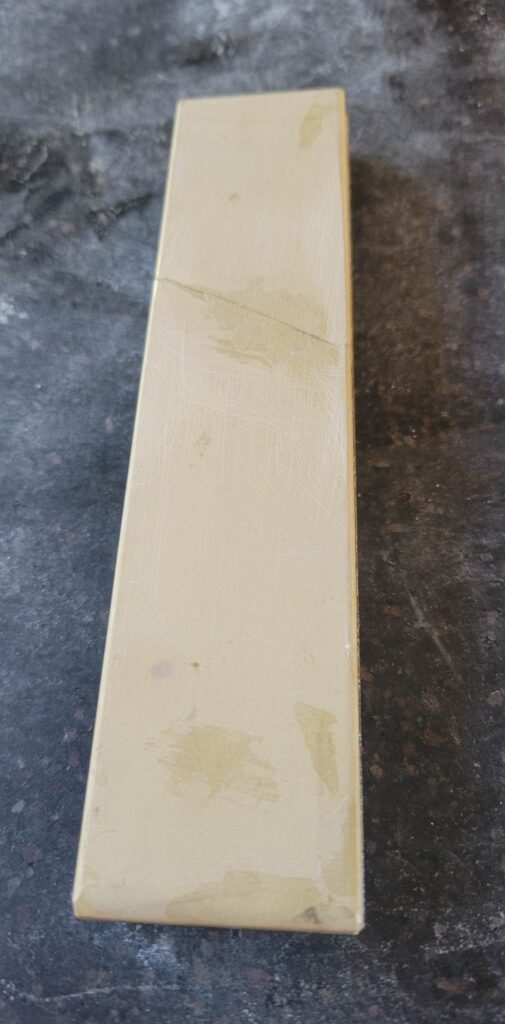
La Veine aux Clous Coticule
Notes
These often feel coarse to the hand because of their soft and hole-filled structure. They work better than they feel. This layer was not seriously commercially sold and is very rare, coming more from local collections or old personal supply. Apparently, they came from an area of the mine that fell down (due to the softness) and were not intentionally mined.
Visuals
It has a visually porous and open structure to its surface, often with larger holes and dark spots through its BBW layer. It has the gradual shift from Coticule to BBW layer that La Grise has, but the other visual qualities it has regarding the holes and a blueish tint to its Coticule layer helps to differentiate it.
Performance
On the soft end of the scale for coticules, it can be scratched with a fingernail. It will auto-slurry (with razors even) with ease and often are very slow due to a lower percentage of garnets than other coticules. This slowness and softness though can allow for a fantastic razor final finish under water, but do not expect to make much headway on any real bevel work or cutting speed. It works a lot like a soft JNAT in a way.
Suitability
Razors
